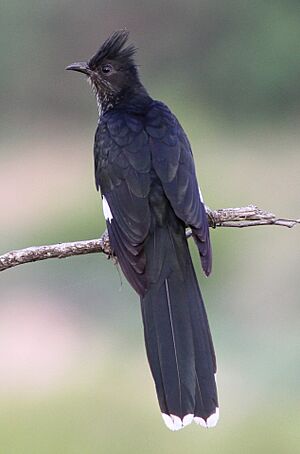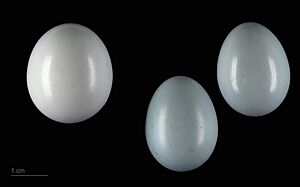Levaillant's cuckoo facts for kids
Quick facts for kids Levaillant's cuckoo |
|
|---|---|
 |
|
| Conservation status | |
| Scientific classification | |
| Genus: |
Clamator
|
| Species: |
levaillantii
|
The Levaillant's cuckoo (scientific name: Clamator levaillantii) is a cool bird that lives in Africa, south of the Sahara desert. It likes to live in bushy areas. This cuckoo is special because it's a brood parasite. This means it lays its eggs in the nests of other birds, like bulbuls and babblers, instead of building its own nest. This bird was named after François Le Vaillant, a French explorer and bird expert.
What Does the Levaillant's Cuckoo Look Like?
This cuckoo is about 37.5 cm (15 in) long. It has a longer tail than the pied cuckoo. Its throat has more streaks or stripes.
Levaillant's cuckoo comes in two main color forms, called morphs:
- Light morph: This bird is black on its upper body. It has a slight blue or green shine. The streaks on its throat can go down its sides. Its wing tips and tail feather tips are white.
- Dark morph: This bird is mostly black. It has a white patch on its wings. It also has white spots on its outer tail feathers.
Young Levaillant's cuckoos look different. They are brown on top. Their wing-coverts (feathers covering the wings) and tail tips are reddish-brown. Their forehead, face, and underparts are a light yellowish-brown. Their throat has more streaks.
You can often hear this cuckoo. Its call sounds like a low, ringing kuwu-weer, kuwu-weer.... It also makes an excited ku-wi-wi-wi sound.
Levaillant's Cuckoo's Unique Habits
The Levaillant's cuckoo is a brood parasite. This means the female bird lays her eggs in the nests of other bird species. She doesn't build her own nest or raise her own chicks. She often chooses the nests of babblers, such as the southern pied babbler (Turdoides bicolor), the bare-cheeked babbler (Turdoides gymnogenys), the Hartlaub's babbler (Turdoides hartlaubii), or the arrow-marked babbler (Turdoides jardineii).
Both the male and female cuckoo work together to trick the host birds. They fly around in a fancy way to distract the host parents. While the male keeps distracting them, the female quickly lays her egg in the nest.
Unlike some other cuckoo species, the newly hatched Levaillant's cuckoo chick does not push the other eggs or baby birds out of the nest. It stays with the host family. The young cuckoo leaves the nest after about ten days. It becomes fully independent and can take care of itself in about four to six weeks.




